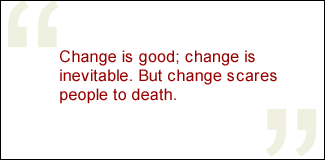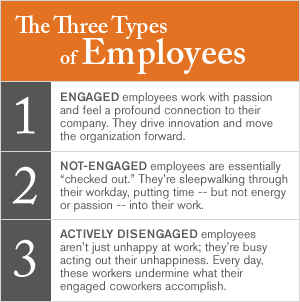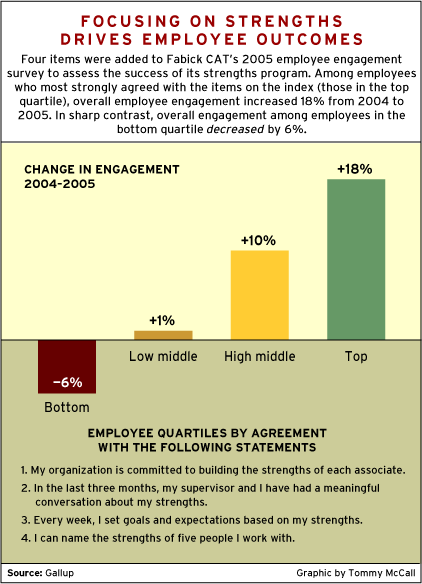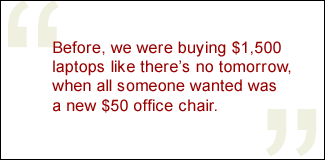Three million dollars. That's what Doug Fabick figures Fabick CAT made last year on a $500,000 investment, which, says Fabick, "Is a pretty damn good return." In fact, that's a 600% return on investment -- enough to make even Berkshire Hathaway stockholders jealous and to inspire CFOs to ask pertinent questions about Fabick CAT's investment strategy. But that half million dollars didn't go into new equipment, buildings, or technology. In fact, there's almost nothing tangible to show for it. Instead, Fabick CAT invested $500,000 on its people. And people are how Fabick CAT made $3 million back.
 |
Fabick CAT sells, rents, and repairs Caterpillar construction equipment. The company serves construction businesses and contractors in 61 counties in southern Missouri and 36 counties in southern Illinois, as well as pipeline construction contractors around the world. Founded by John Fabick in 1917, Fabick CAT now has more than 600 employees in 12 locations -- each considered a company in its own right -- with headquarters in Fenton, Missouri. Fabick CAT is still a family-owned business, and Doug Fabick, its president, is the fourth-generation Fabick to lead the company.
In 1999, Doug Fabick took over from his father, who told him to "make his splash" and build his team. Fabick realized he had a challenge -- Fabick CAT wasn't even in the top 25% of America's 50-plus CAT dealerships. It wasn't a comfortable place for the competitive Fabick, and clearly, something had to change. But change is not a beloved concept in the heavy equipment industry.
"Change is the constant of the world. Change is good; change is inevitable. But change scares people to death," says Fabick. "CAT dealerships are twenty years behind the times. Technology doesn't do much for us -- you can't send a big old yellow CAT over the Internet -- so we don't change unless we have to."
Fabick decided that it was time to change, though he wasn't sure what change, exactly, to make. So he analyzed the company, thoroughly researching every standard business indicator. Nothing turned up. Then he started analyzing businesses run by his friends at other CAT dealerships. He asked for their organizational charts, figuring that because CAT dealerships all do and sell the same things, the charts would clearly show one system that worked best. But there wasn't one. Some CAT dealers did well, while others didn't, but there was no indication as to why. So he called the dealers and asked them point-blank. He got nowhere.
"They couldn't tell me how they got to be so successful because they didn't know," Fabick says. "So when I hung up the phone, I could only think [that the reason] they do well is because that guy does it well. That's why he's got these two departments doing great and some other guy doesn't, because the other guy doesn't have that experience. Or something."
Fabick began to wonder if other dealers even understood why they were so successful. He kept studying, moving his people around, trying to figure out how to make his company CAT's best dealership. "I kept looking and learning, looking and learning. Then I read First, Break All the Rules and Good to Great." What Fabick learned from those two bestselling management books is that some people have innate talent for their jobs -- and that those people can be identified and deliberately placed in the job roles for which they were born.
"Boom! That made it click in my head -- that's why it's different in every dealership," says Fabick. "They're putting the right people in the right jobs. But they didn't know it. They're just unconsciously letting the cream rise to the top."
Armed with his insight, Fabick attended a Gallup-sponsored management summit in 2001. He absorbed the research on employee engagement, especially as it pertained to the right fit for the right job, and the linkages between engaged employees, engaged customers, and increased profit. In 2002, he hired Gallup to administer its 12-item employee engagement survey, the Q12, at Fabick CAT and to train his managers to facilitate engagement.
Getting it wrong the first time
The news from the first assessment in 2002 wasn't good. Only 16% of Fabick CAT's employees were engaged, or fully committed to their work, and the company's overall engagement scores placed it in the bottom quarter of the companies Gallup had studied. (See graphic "The Three Types of Employees.") This was hardly unexpected -- companies often see low engagement results from the first administration -- but it wasn't a good sign, either. Employee engagement has direct relationships to retention, productivity, profitability, safety, absenteeism, and customer engagement.
Business leaders understand that the first engagement assessment reflects a baseline measurement and that subsequent administrations indicate change. Unfortunately, Fabick CAT's results weren't any better the second time -- the percentage of engaged employees in 2003 was still stuck at 16%.
No one was very surprised. Fabick CAT was in the midst of a company-wide IT change; Caterpillar was implementing a new computer system and introducing new machinery, and the dealership was integrating three recently acquired stores, which added 30% more employees. Many managers didn't yet understand the value of focusing on engagement. What's more, the rank and file harbored a certain amount of distrust.
"Their initial reaction was, 'Is this just a flavor-of-the-month thing? Are they going to ask me eight billion questions and ignore the answers? Because if you don't do anything [with my responses], I don't care.' And I don't blame them for thinking that," says Fabick. But the disappointing results of the second Q12 administration galvanized a few of Fabick's managers, notably Don Mercille.
 |
Mercille's parts department was and is Fabick CAT's most engaged workgroup, and Mercille believes that no employee engagement program will work if it's merely an annual survey. "I wanted to show that this wasn't just a local program," says Mercille, "and it wasn't going away. We wanted employee engagement to be a culture and way of life at Fabick CAT, not just a program. It's very much part of our strategic plan."
After the second wave's results were disseminated, change started to seem less optional. Every workgroup created impact plans based on their engagement results -- they decided where the problem areas were, how to fix them, who would lead the charge, and how they would evaluate their efforts. (See "What to Do With Employee Survey Results" and "You've Gotten Employee Feedback. Now What?" in the "See Also" area on this page.)
In the parts department, Mercille made himself a fixture at impact planning sessions. Then, as the employees started becoming more involved in the process, Mercille stepped back and let them take control. The employees' outlook started to change, moving from outright skepticism to anticipation of the next results. This time, having worked harder, they had reason to expect better.
Fitting the parts together
Fabick paid a lot of attention to what Mercille and his other highly effective managers were doing and realized that their success boiled down to communication. "Communication is key -- one workgroup at a time, one location at a time," says Fabick. By the third Q12 administration, the percentage of engaged employees had increased to 33% -- a significant change. (See graphic "Boosting Employee Engagement at Fabick CAT.")
That's when Fabick realized that to continue the culture changes at Fabick CAT, he still had more to do. It was time to start putting "the right people in the right jobs," then help them maximize their performance through strengths-based development.
 |
"It's not rocket scientist stuff; it's really just connecting with people in the right way," says Mercille. So in 2004, to increase employee engagement, Fabick CAT started systematically investing in developing the talents and strengths of its parts, service, sales, and operations managers. The company provided managers with in-depth training on how to manage to increase engagement, and it began using Gallup-developed interviews to select new people and managers who had the right talents to succeed in their roles. Fabick CAT also invested in training its salespeople to help them become more effective in meeting and exceeding customer expectations.
But Fabick CAT didn't stop there; the company knew it also needed to connect with customers. So the company began using Gallup's customer engagement metric to gauge and improve the strength and depth of its customer relationships.
These initiatives required a big investment of time and money. But by the end of 2005, Fabick CAT's leadership was pretty sure they were on to something.
And they were right.
A leading indicator of performance
Although these initiatives were deployed throughout Fabick CAT, Gallup research has found that the best place to measure their business impact is at the local level. And because Fabick CAT's improvement programs could track changes at the workgroup level, the company could spot which groups were improving and which needed help.
To help Fabick CAT measure the impact of its initiatives, Gallup conducted an analysis to determine how the initiatives influenced performance outcomes. This analysis focused on three areas: how a focus on strengths drives employee engagement, how hiring for talent drives employee and performance outcomes, and how employee engagement drives performance outcomes.
First, Gallup researchers measured the impact of strengths-based learning and development on employee engagement by adding a four-item index to the 2005 employee engagement survey, then sorting employees into quartiles based on their responses. They discovered that employees who felt they were working in a strengths-based environment were more engaged, while those who felt they were not working in a strengths-based environment actually showed a decline in their engagement from 2004 to 2005. (See graphic "Focusing on Strengths Drives Employee Outcomes.")
 |
The second analysis examined the connections between hiring for talent and performance outcomes. The results showed that managers with the greatest talent fit for their role are the best at driving employee engagement by encouraging a strengths-based working environment; they also excel at conducting impact planning sessions and following up on their workgroup's impact plan. And consistent with other Gallup research, Fabick CAT salespeople with a better talent fit for their role had a higher market share, or "percent of industry net sales," (PINS) than those with a lesser talent-to-role fit.
But perhaps the most intriguing results were found when researchers examined the connections between employee engagement and sales growth and customer engagement. When sales groups were divided into two halves by engagement levels and compared, groups in the top half increased their overall PINS by 24%, while groups in the bottom half increased their PINS by just 8% overall. Similarly, groups in the top half had overall customer engagement scores that were 8% higher than groups in the bottom half.
The bottom line
In 2005, Fabick CAT invested about $500,000 in Gallup programs. During this same time, Fabick CAT's profit increased by 100%, while revenues only increased by 15%.
But according to Doug Fabick, those numbers don't tell the whole story -- and he points to a strange coincidence. "We spent $500,000 on these programs, but we cut capital expenses by $500,000 too. We were spending less money and getting more people what they really wanted," he says. "Before, we were buying fifteen-hundred-dollar laptops like there's no tomorrow, when all [someone] wanted was a new fifty-dollar office chair."
 |
The profit and revenue increases that Fabick CAT has realized are compelling; so is a 600% return on investment. But they might distract attention from another important transformation at Fabick CAT -- the changed culture. "We're changing our culture from a bureaucracy and becoming more open. It's bringing us together [and changing us] from a bunch of little kingdoms to one team," says Fabick.
That's a return on investment in people. To the sixth leader of a family-owned business, that's just as gratifying as the investment that can be counted in dollars -- because it's the "splash" Doug Fabick's dad told him to make.